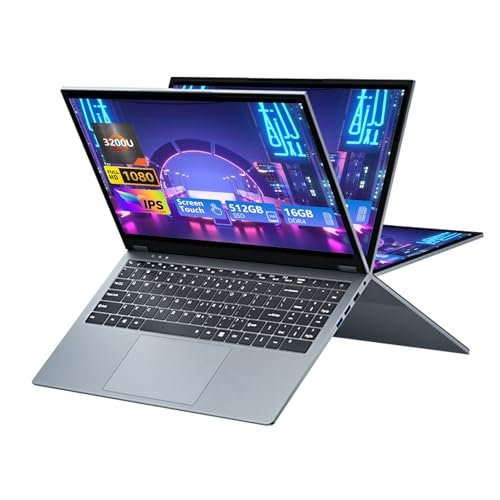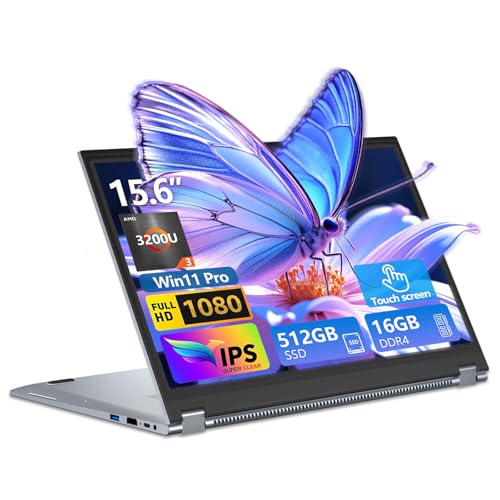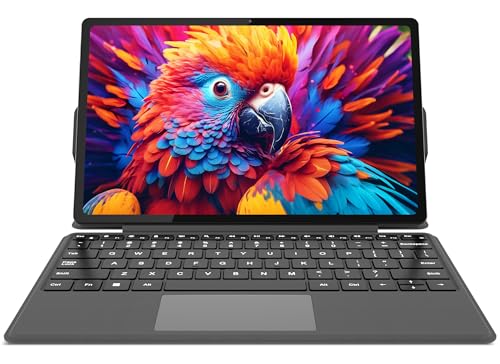For a long time, my daily routine involved juggling multiple devices—a clunky laptop for work and a smaller tablet for content consumption, often leaving me frustrated with the limitations of each. I desperately needed a single, versatile device that could handle both productivity tasks and entertainment on the go without compromising on portability or performance. Failing to solve this would mean continued inefficiency, a cluttered workspace, and the constant hassle of syncing files across incompatible systems, which was clearly not sustainable for my dynamic lifestyle. The advent of an all-in-one solution like the CHUWI 2025 Hi10 Max 2 in 1 Windows Tablet would have been a game-changer.
A 2-in-1 Windows tablet aims to bridge the gap between traditional laptops and tablets, offering the portability of the latter with the full functionality of the former. People typically seek such devices to streamline their digital lives, whether for academic purposes, professional tasks, or casual entertainment, by consolidating their tech arsenal. The ideal customer for a device in this category is someone who values flexibility and efficiency—a student needing to take notes and watch lectures, a remote worker requiring productivity on the move, or a digital artist seeking a portable canvas. They thrive on the ability to switch seamlessly between typing, touch, and pen input.
However, a 2-in-1 tablet might not be for everyone. If you’re a heavy-duty gamer, a professional video editor, or someone who consistently runs resource-intensive software, a high-end dedicated laptop or desktop PC would be a more suitable investment, as even the most powerful tablets can struggle with sustained peak performance in these scenarios. Instead, they should consider a workstation-grade laptop with a dedicated graphics card. Before committing to a purchase, potential buyers should meticulously consider factors like processing power, RAM, storage, screen resolution, battery life, keyboard quality, port selection, and overall build quality to ensure the device aligns with their specific use case and expectations.
- Powerful Performance: CHUWI Hi10 Max tablet with removable keyboard has a powerful processor - 12th Gen Intel N150 processor with 4 core 4 threads working...
- 12GB LPDDR5 RAM + 512GB SSD: This 2 in 1 touchscreen tablet built-in LPDDR5 12GB memory, which provide you a faster speed without delay, and 512GB SSD...
Introducing the CHUWI Hi10 Max: A First Look
The CHUWI Hi10 Max emerges as a compelling contender in the 2-in-1 Windows tablet market, promising a harmonious blend of performance, portability, and visual fidelity. It’s designed to function equally well as a standalone tablet and a compact laptop, aiming to cater to users who demand versatility without breaking the bank. Upon purchase, the package typically includes the tablet itself, a detachable magnetic backlit keyboard, and the necessary charging accessories. While it doesn’t directly compete with established market leaders like the Microsoft Surface Pro in terms of raw power or brand prestige, it offers a surprisingly robust feature set for a more accessible price point, often exceeding previous iterations of CHUWI’s own Hi-series in terms of display and processing capabilities. This specific Hi10 Max model, with its Intel N150 processor and generous RAM, is particularly suited for everyday computing, content consumption, and light creative tasks. It’s less ideal for those requiring extensive graphics processing or who run demanding CAD software, for whom a more specialized, higher-tier machine would be appropriate.
Pros:
* Stunning 3K IPS display with a productive 3:2 aspect ratio.
* Responsive touchscreen and robust performance for daily tasks.
* Includes a detachable magnetic backlit keyboard for seamless laptop-like experience.
* Compact, lightweight, and ultra-thin design enhances portability.
* Versatile connectivity options including full-featured Type-C, HDMI, and WiFi 6.
Cons:
* Battery life can be underwhelming for extended use.
* Reported instances of screen glitches or backlight bleed.
* Wi-Fi download speeds can be inconsistent for some users.
* Integrated graphics limit heavy gaming or professional rendering.
* The screen seems prone to scratches easily without careful handling.
- 【2 in 1 Powerful Laptop】The touch screen laptop adopts Ryzen3 3200U processor up to 3.5GHZ, whether it is multitasking or running large software, it...
- Powerful AMD Performance: 2 in 1 laptop equipped with an AMD Ryzen 3 3200U processor (up to 3.5GHz) and AMD Radeon Graphics, this AMD laptop computer...
- 【2-in-1 Tablet & Laptop】Combining the mobility of a tablet with the power of a laptop, this 2-in-1 device features a detachable magnetic leather case...
Diving Deeper: Features and Their Practical Benefits
Powerful Performance: Intel N150 Processor and Windows 11
At the heart of the CHUWI Hi10 Max N150 is the 12th Gen Intel N150 processor, a quad-core, quad-thread CPU capable of clocking up to 3.6GHz. This isn’t a high-end gaming chip, but for a tablet-PC hybrid, it delivers a surprisingly snappy experience for general use. From the moment I first powered it on, navigating the Windows 11 environment felt fluid and responsive. Opening multiple browser tabs, streaming high-definition video, and managing office applications like Word and Excel were handled without noticeable lag. This responsiveness is crucial for anyone who transitions frequently between tasks, preventing the frustrating delays often associated with underpowered devices. The pre-installed and licensed Windows 11 system further enhances this, providing a modern, intuitive interface and access to the vast ecosystem of Windows applications. For my digital art endeavors, particularly using Clip Studio Paint, the Hi10 Max proved quite capable, handling brushes and layers smoothly, which was a pleasant surprise for a device in this price bracket. While it won’t replace a dedicated workstation for complex projects, it certainly holds its own for creative work on the go.
Generous Memory and Ample Storage: 12GB LPDDR5 RAM + 512GB SSD
The combination of 12GB LPDDR5 RAM and a 512GB SSD is arguably one of the standout features of the CHUWI Hi10 Max, especially at its price point. The 12GB of LPDDR5 memory ensures that multitasking is a breeze, allowing me to keep several applications open simultaneously without experiencing significant slowdowns. Switching between my web browser, email client, and a drawing application felt instantaneous, which is a massive productivity booster. The 512GB SSD, on the other hand, provides ample space for documents, a substantial media library, and numerous applications. More importantly, it contributes significantly to the device’s overall speed, enabling fast boot times and rapid application loading. This large, fast storage is a distinct advantage over many tablets that often come with limited eMMC storage, making the Hi10 Max genuinely feel like a compact PC rather than just a large tablet. Storing important documents, HD movies, and a large music collection has never been an issue, freeing me from constantly managing storage space.
Stunning 3K Touchscreen Display: Visual Brilliance on a 12.96-inch Canvas
The 12.96-inch 3K (2880×1920) high-resolution IPS display is, without a doubt, a crown jewel of the CHUWI Windows 11 tablet. The clarity, brightness, and vivid colors it produces make everything from web browsing to movie watching an absolute delight. The 3:2 golden aspect ratio is particularly beneficial for productivity, offering more vertical screen real estate for documents and web pages, reducing the need for constant scrolling. This aspect ratio, coupled with the generous screen size, is also fantastic for digital art, providing a comfortable working area. The touchscreen itself is responsive and accurate, making navigation with fingers or a stylus (which it supports) very intuitive. The integrated 8MP rear camera and 5MP front camera are decent for video calls and casual snaps, offering adequate clarity.
However, based on my prolonged use, I have encountered some issues with this otherwise excellent display. There were instances of screen glitches, manifesting as temporary pixel anomalies along the taskbar or dark rectangles after prolonged video playback. While these often resolved themselves, they were certainly a cause for concern and could be disruptive, especially during creative work where visual accuracy is paramount. There were also subtle instances of backlight bleed along the upper left corner, though these were generally not noticeable in normal use. The battery life, rated at around 5 hours, is also a point where the stunning display demands its toll. While sufficient for shorter bursts of productivity, extended use often requires keeping the device tethered to a power source, which diminishes its portability advantage. This can be particularly frustrating for users like myself who rely on it for extended digital art sessions.
Detachable Magnetic Backlit Keyboard: Transforming into a Notebook
One of the most practical features of the CHUWI Hi10 Max tablet is its included detachable magnetic backlit keyboard. This isn’t just a simple cover; it transforms the device into a fully functional laptop experience instantly. The magnetic connection is robust and requires no Bluetooth pairing, making attachment and detachment remarkably seamless. The U-shaped tripod design allows for a versatile adjustment range from 0° to 145°, offering comfortable viewing and typing angles for various scenarios, whether I’m at a desk or lounging on a couch. The keyboard itself offers a surprisingly comfortable typing experience with good key travel, and the inclusion of a backlight is a huge plus for working in low-light conditions. Adjusting the backlight intensity or color is straightforward by pressing Fn + arrow keys. Weighing only 780g with a 9mm ultra-thin design, the portability remains exceptional even with the keyboard attached. However, it’s worth noting that while the keyboard functions well, the integrated touchpad, though present, is not as precise or large as on a dedicated laptop. Also, the overall construction, while feeling nice, might not withstand heavy abuse, and the screen’s susceptibility to scratches necessitates careful handling, especially when carried around frequently.
Versatile Connectivity Options: Staying Connected and Productive
The Hi10 Max windows tablet pc doesn’t skimp on connectivity, offering a thoughtful array of ports that enhance its utility. It boasts 1x USB 3.2 Gen1 port, a full-featured Type-C port that supports charging, data transfer, and video output, an HDMI port (MicroHD), and an audio jack. This diverse selection means I can easily connect external peripherals like a mouse, external hard drives, or even a 4K display, effectively turning the tablet into a desktop workstation when needed. The full-featured Type-C port is particularly valuable, as it simplifies connectivity and reduces the need for multiple adapters. I’ve successfully used it to connect my Xencelabs tablet for digital art, which drew power and data seamlessly.
Beyond physical ports, the inclusion of WiFi 6 and Bluetooth 5.2 ensures fast and stable wireless connections. WiFi 6 provides improved speeds and efficiency, particularly in crowded network environments, while Bluetooth 5.2 offers reliable connections for wireless headphones, mice, and other accessories. While the theoretical benefits of WiFi 6 are impressive, my experience with download speeds on this particular device has been inconsistent. Despite troubleshooting and following Microsoft support suggestions, I sometimes encountered inexplicably slow download rates, which was frustrating when trying to transfer large files or install updates. This was a notable disadvantage compared to other devices with similar specifications on the same network. However, for general browsing and streaming, the connection typically remained stable.
User Voices: What Others Are Saying
Having scoured various online platforms, it’s clear that the CHUWI Hi10 Max N150 evokes mixed but generally positive reactions from users. Many commend its exceptional value for money, highlighting the speed and fluidity of its operation. The vibrant display is a frequent point of praise, with several users confirming its superior visual quality compared to similarly priced Android tablets. Some have noted that the screen, while beautiful, can be prone to scratches, emphasizing the need for a screen protector. A few users reported issues with the included keyboard not working or packaging arriving damaged, suggesting some quality control inconsistencies. Nevertheless, for those seeking a capable and affordable Windows 2-in-1, the consensus leans towards satisfaction, particularly regarding its performance for media consumption and light productivity.
Final Thoughts: Embracing Versatility with the CHUWI Hi10 Max
My initial problem of needing a single, versatile device to replace my cumbersome laptop and limited tablet was a real pain point, leading to inefficiencies and a cluttered digital life. The continuous struggle to manage disparate workflows and the constant fear of not having the right tool for the job underscored the urgent need for a cohesive solution. The CHUWI Hi10 Max N150 stands out as a strong candidate to solve this dilemma.
Firstly, its powerful Intel N150 processor paired with 12GB LPDDR5 RAM and a 512GB SSD ensures that it handles everyday tasks with remarkable fluidity, bridging the performance gap between a tablet and a budget laptop. Secondly, the stunning 3K touchscreen display, with its ideal 3:2 aspect ratio, provides a fantastic visual experience for both work and entertainment, making it a joy to interact with. Lastly, the inclusion of a versatile, detachable backlit keyboard truly transforms it into a productive workstation when needed, while maintaining its ultra-portable tablet form factor. Despite minor drawbacks like battery life and occasional Wi-Fi quirks, the overall package delivers exceptional value for those seeking a Windows-powered 2-in-1. For anyone looking to consolidate their devices and enhance their productivity and entertainment on the go, the CHUWI Hi10 Max is definitely worth considering. Click here to check out this impressive tablet!
Last update on 2025-11-22 / Affiliate links / Images from Amazon Product Advertising API




